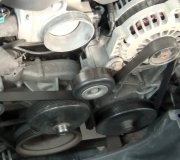The MAP and O2 sensors have the biggest effect on fuel mileage. As long as the voltage readings are within specified limits, no fault code will be set in memory but the engine computer will respond accordingly to the incorrect values. A vacuum leak in the hose to the MAP sensor will mimic acceleration, and the computer will command a richer mixture from the injectors. An exhaust system leak ahead of the oxygen sensor will draw in air between the exhaust pulses from the engine. The sensor sees the unburned oxygen so it tries to increase fuel delivery. There will be too much raw fuel going out the exhaust, but the sensor doesn't measure unburned fuel, it still sees the unburned oxygen, so it keeps trying to enrich the mixture. You should see black smoke and smell the unburned fuel at the tail pipe, but the computer still thinks it's running too lean.
The torque converter should lock up above 45 mph strictly as a fuel savings feature. If you have a tachometer on the dash, you can watch the operation; if not, you'll have to listen carefully to the engine. While traveling at highway speed, and the engine is warmed up, hold the gas pedal steady, then very lightly tap the brake pedal for just a fraction of a second. Engine speed should increase about 200 rpm for about two seconds, then go back down as the converter locks up again. The torque converter unlocks when you tap the brake pedal or take your foot off the gas pedal in preparation for an expected stop. If there's no indication the torque converter is locking up properly, first try pulling the brake pedal up a little with your foot while driving on the highway. If it locks up now, suspect a brake light switch out-of-adjustment.
Another thing I've been running into more and more lately is a locked up brake caliper. Stop on a small incline, then put the car in neutral and take your foot off the brake pedal. The car should creep downhill on its own. You should also be able to push the car by hand on a flat surface. If not, feel around the center of the two front wheels. If one feels hot, that brake has been dragging. The common cause is the rubber hose is constricted by rust buildup inside the metal bracket that's crimped around the center of the hose. Opening that crimp just a little with a channel-lock pliers will solve the problem. After working on cars for 26 years, and never seeing this problem even once, I ran into it twice in two weeks. One was a Caravan I had parked for the winter, and the next one was on a student's Neon. When this problem occurs, you can find it very easily if you jack the front end off the ground and put the transmission in neutral. You will be able to rotate one tire very easily by hand. The other one will not turn at all unless you open the brake caliper's bleeder screw to release the pressure.
Caradiodoc
Wednesday, June 3rd, 2009 AT 4:04 PM



